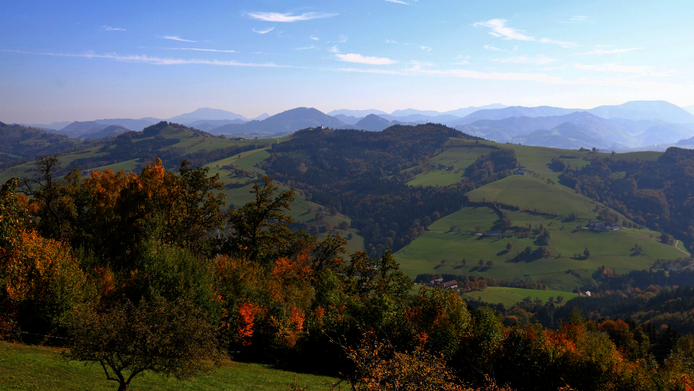Scenarios for future land use

“You can't have your cake and eat it” is the adage applied to a situation in which you have to choose between two options. If both can’t be enjoyed at the same time, economists speak of a “trade-off”, or conflicting goals. “Everything – what we eat or consume, including clean air and water, a good CO2 balance-sheet, energy production, erosion control, pollutant disposal, leisure and tourism, nature conservation, jobs or the very roof over our heads – ultimately comes down to a question of land use,” explains Martin Schönhart from the Institute for Sustainable Economic Development at the University of Natural Resources and Applied Life Sciences in Vienna. To stay with the metaphor, there is no such thing as a “free lunch” here, as the land use expert points out. If high crop yields through intensive cultivation are achieved on a given field, that same field usually generates fewer benefits for the ecosystem such as soil protection, water filtration, cooling, pollination etc. and plays host to a lesser degree of biodiversity. For the European project “Towards multifunctional agricultural landscapes in Europe”, or TALE for short, the researchers at the Institute for Sustainable Economic Development developed realistic – but quite extreme – scenarios in order to assess the trade-offs. They also drew up methodological protocols for the discussion of land use scenarios. In five model regions, experts from agriculture, nature conservation, regional development, tourism and civil society engaged in moderated stakeholder discussions about the potential future use of land areas, the types of use, the different categories of areas and possible impacts.
To share or to spare – that is the question
With support from the Austrian Science Fund FWF, the team at the University of Natural Resources and Applied Life Sciences (Martin Schönhart was assisted by Katrin Karner and Erwin Schmid) participated in an ERA-NET joint project, coordinated by the Environmental Research Centre Leipzig-Halle, with further partners in Spain, Germany, the Netherlands and Switzerland. “Some people disparage such stakeholder discussion processes as unscientific. As a matter of fact, however, we have no other option for talking about the future than by discussing scenarios based on well-founded parameters, land use data and accepted indicators,” says Martin Schönhart in repudiating potential criticism. In concrete terms, the researchers worked on the basis of two scenarios dubbed “land sparing” and “land sharing”. “Land sparing” focuses on protected sites and fallow land that are intended to compensate for intensively used areas. The concept is particularly widespread in Australia, North and South America, where land is abundant. In Europe the preferred approach is the shared use of the same area with appropriate trade-off management between “productivity” and “naturalness”. For both scenarios, the researchers broke down how they affect the development landscape, in which cases area use, urbanisation or infrastructure would be (im)possible, how attractive such a landscape is and what it achieves.
Possible conflicts of use in Mostviertel
Martin Schönhart has been working in the Mostviertel region, the north of which is intensively used for agriculture, since his doctoral thesis. The southern part of that region, on the other hand, is dominated by grassland and cattle farming, and one is more likely to find extensively tended orchard meadows and a great variety of landscape elements there. These are marketed as a tourist attraction: “For the first time, we are introducing biodiversity and countryside appeal as values in land use, thus creating a tangible picture of potential conflicts. At the outset, the stakeholders assessed the current situation of the region and then discussed what future land use was plausible.” This was followed by concrete quantification and categorization: which areas were to be used and in what way, and which would no longer be used. Based on this, future landscapes were modelled in illustrative maps and discussed once again.
Trends and necessary changes
Stakeholders agreed that a countryside balanced in terms of ecosystem output and inclined towards “land sharing” more closely met their requirements. They are currently witnessing how extensive grassland management is being abandoned, which means that such areas will become overgrown by shrubs and trees. In other places meanwhile there is intensification of management wherever this is agronomically possible. That would rather correspond to the idea of “land sparing”. TALE analysed innovative agricultural policies, such as cooperatives for agricultural environmental protection, which offer opportunities to offset current trends. Stakeholders were aware, however, that there was a need for other changes as well, for example in people's consumer behaviour, in order to maintain or achieve certain land uses. About two thirds of Austria’s national territory are taken up by mountains. For the remaining third of the total area, the figures reported for soil loss are alarming. Hence, the results of this project come just in time to shape future-oriented policies for agriculture, climate protection and nature conservation.
Personal details Martin Schönhart is a graduate of the University of Natural Resources and Applied Life Sciences, Vienna. As a research associate at the Institute for Sustainable Economic Development he focuses on integrative land use modelling, climate change and ecosystem services.
More information about the project https://www.ufz.de/tale/
Publications





